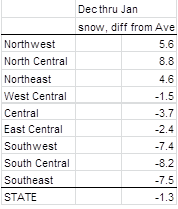This past season was my best pheasant hunting season in several years. Every time that my group went out we were able to take at least one bird, something that hasn’t happened in some time. I wanted to know what to expect from 2017, so I spoke with several DNR officers, including Matt Dollison, the wildlife biologist for the Nishnabotna unit in southwest Iowa. We spoke about last year’s numbers, the impact of a warm winter and what to watch for this spring. Here is what I learned.
Where We Are: 2016
Pheasant numbers are trending upwards. Pheasant population estimates are based off of the August Roadside Survey, which “is conducted on sunny calm, mornings, with a heavy dew on the grass, between August 1st-15th of each year” (Iowa DNR Roadside Survey). There are usually 2 routes per county. In 2011, after five consecutive years of above-average snowfall, the average count for a 30-mile loop was 7 pheasants. In 2016 it was 21. Though this number was a slight decrease from 2015 (24), 270,000 roosters were shot the year before, which was the best harvest in 5 years. Thus, a small dip is not significant. Additionally, quail numbers are at their highest point in the last 27 years. In the past quail and pheasant numbers were similar, but as Iowa transitioned away from oats and hay toward corn and soybeans the numbers of quail plummeted. Though numbers will never reach what they once were, the recent streak of mild winters has greatly improved the population.
Where We Are: So Far in 2017
Snow is th e biggest determinant of pheasant populations. Specifically, the amount of snow and duration of the time it remains impact pheasants ability to find food and hide from predators. The winter has been very mild and snowfalls have been below average for almost every area of the state. The only areas which have had above average snowfall are in northern Iowa, which have the highest pheasant populations to begin with. Therefore, pheasant populations have likely remained strong across the state throughout the winter.
e biggest determinant of pheasant populations. Specifically, the amount of snow and duration of the time it remains impact pheasants ability to find food and hide from predators. The winter has been very mild and snowfalls have been below average for almost every area of the state. The only areas which have had above average snowfall are in northern Iowa, which have the highest pheasant populations to begin with. Therefore, pheasant populations have likely remained strong across the state throughout the winter.
What to Watch For
Cold, wet springs are very hard on pheasants. Chicks can easily get hypothermia and die. Additionally, cold weather reduces the number of insects available for consumption. Pheasants need a 42% nest success rate in order to have an increase in population. If more than 8″ of rain falls in April and May, 42% success is almost never reached. Pheasant numbers have increased only once in the last fifty years following such heavy rains.
Lastly, we hope to see increased habitat. Iowa lost 2,400 square miles of CRP between 1990 and 2011. And, though a mild winter and spring will help, more habitat is also needed. Thus, we hope to see a relatively warm, dry spring, and numbers should be solid for next year, potentially even reaching 30 pheasants per loop.
Thank you for reading, and special thanks to Lewis Bruce and Matt Dollison for all of the information. Stu.